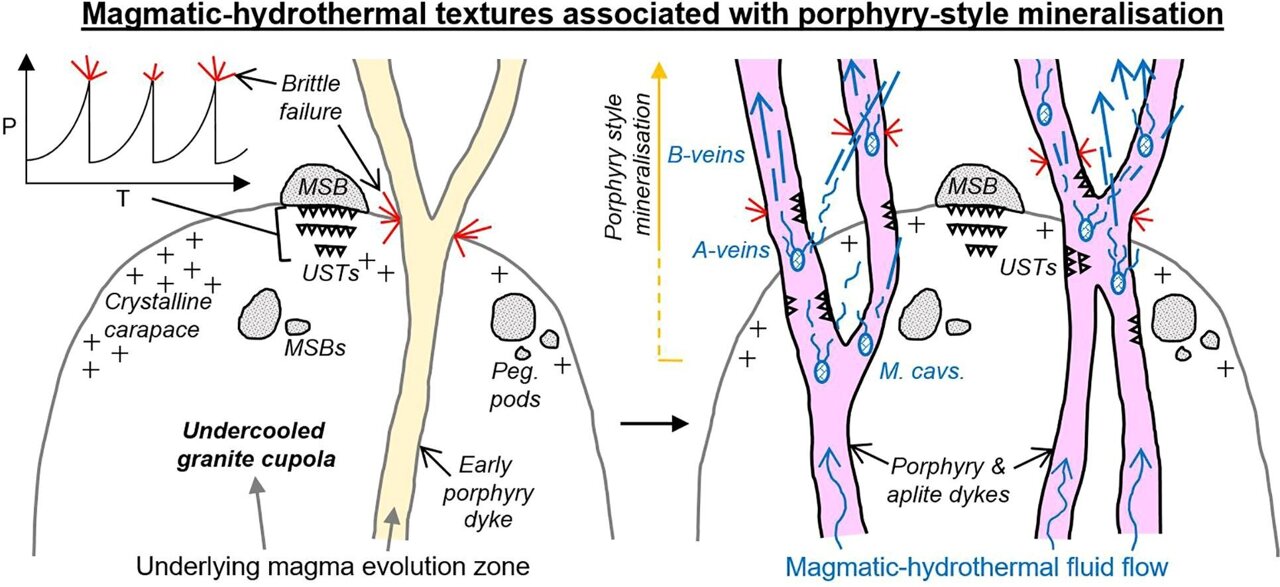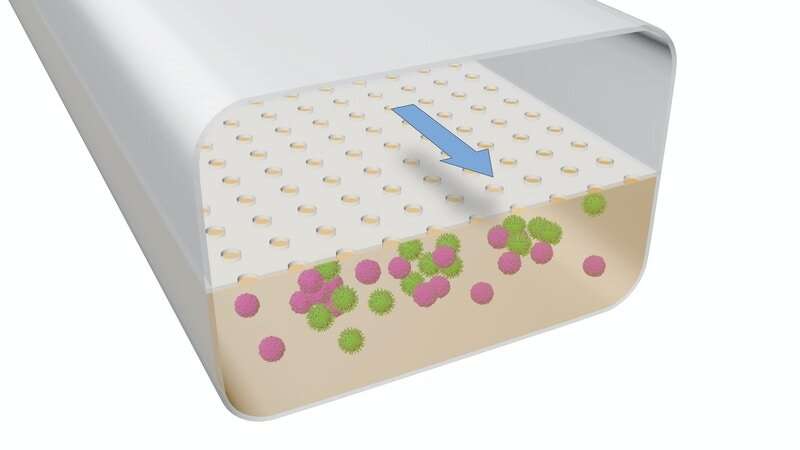
Previous understanding of such textures was disjointed
Scientists have developed a new toolkit for the discovery of mineral deposits crucial to our transition to a ‘green economy’.
A study led by Lawrence Carter from the University of Exeter’s Camborne School of Mines, has given fascinating new insights into how to discover porphyry-type copper deposits.
Porphyry-type deposits provide most of the world’s copper and molybdenum, as well as large amounts of gold and other metals, which are of increasing demand for green technologies such as electric vehicles, wind turbines and solar panels, and for power transmission. They are the principle target of many mining companies who employ a wide range of invasive and expensive exploration techniques to find them.
Porphyry-type deposits originally form several kilometres below the Earth’s surface above large magma chambers. Not only are they rare but most large near-surface examples have already been found. To meet future demand for copper, new methods are needed to discover deeper and possibly smaller deposits – using techniques that meet increasingly strict environmental regulations.
The researchers show that certain textures preserved in rock may be indicative of the types of physical processes that form these deposits, and may give an early indication of their location.
Previous understanding of such textures was disjointed because they are often small, poorly exposed or are simply not recognised when encountered.
The new study was carried out in the Yerington district of Nevada where tilting of the upper crust has provided a globally unique cross-section through four porphyry-type deposits and their host rocks. Because of this, previous studies in the district have underpinned much of the current understanding of how porphyry-type deposits form.
Lawrence Carter, a final year PhD student and Research Associate at Camborne School of Mines, based at the University of Exeter’s Penryn Campus said: ‘We provide a textural framework for exploration geologists to assess the likely 3D architecture of porphyry-type deposits before employing more invasive and expensive techniques.’
Professor Ben Williamson, co-author of the study and Associate Professor in Applied Mineralogy at Camborne School of Mines added: ‘this innovative applied study, led by one of the UK’s leading young geo-scientists, will provide much needed field criteria for the discovery of economically important and green-technology-crucial porphyry-type deposits.’
Original Article: New toolkit aids discovery of mineral deposits crucial to ‘green economy’ transition.
More from: University of Exeter
The Latest Updates from Bing News & Google News
Go deeper with Bing News on:
Green mineral deposit discovery
- Aston Bay and American West Metals Announce New Copper Targets at the Storm Copper Project, Canada
TORONTO, ON / ACCESSWIRE / May 7, 2024 / Aston Bay Holdings Ltd. (TSXV:BAY)(OTCQB:ATBHF) ("Aston Bay" or the "Company") is pleased to present the preliminary interpretation of the initial results from ...
- Smaller is possible, when it comes to mining
In Central and South America, there are examples of small-scale operations mining copper, zinc, lead silver and gold mines. They are supported by off-the-shelf, modular, adaptable and scalable ...
- IG ASIA Acquires Majority Interest in the Pribrezhniy Porphyry Copper Deposit in the Republic of Kazakhstan
This asset is a flagship project for IG Asia alongside its TN5 project in Mongolia. TN5 is located between world class Oyu Tolgoi and Kharmagtai deposits of Rio Tinto and Xanadu Mines where the target ...
- Discovery of Ghana's lithium deposits generates investment opportunity
With critical minerals a central issue in the global energy transition, Ghana’s 2018 discovery of lithium deposits has brought international attention to the West African country. Five years later, ...
- Rare Earths Reserves: Top 8 Countries (Updated 2024)
Rare earths prices soared to their highest level in 20 months, according to OilPrice.com, in early Q3 2023 coinciding with a temporary production halt in Myanmar, which accounted for 38 percent of ...
Go deeper with Google Headlines on:
Green mineral deposit discovery
[google_news title=”” keyword=”green mineral deposit discovery” num_posts=”5″ blurb_length=”0″ show_thumb=”left”]
Go deeper with Bing News on:
Green economy
- Mining sector to drive green tech, job growth
The country’s abundant mineral resources could fuel green technologies and create a wave of high-quality job opportunities for Filipinos once their full potential is realized, according to the ...
- China Rules the Green Economy. Here’s Why That’s a Problem for Biden.
Beijing’s dominance raises economic and security concerns, and tensions will be high as top climate diplomats meet this week.
- Green Ribbon Panel Unveils New Policy Recommendations for Green Economic Growth on World Asthma Day
Report reveals significant progress on majority of Panel recommendations, stresses maintaining momentum key to a decarbonized economyTORONTO, May 07, 2024 (GLOBE NEWSWIRE) -- On a day dedicated to ...
- New National Climate Plans Must Act As Economic Strategies
Country climate plans, the so-called nationally determined contributions that nations must submit under the Paris Agreement, should not simply be decarbonization ...
- Green New Deal
The Green New Deal will convert the old, gray economy into a new, sustainable economy that is environmentally sound, economically viable and socially responsible. It seeks to solve the climate crisis ...
Go deeper with Google Headlines on:
Green economy
[google_news title=”” keyword=”green economy” num_posts=”5″ blurb_length=”0″ show_thumb=”left”]









